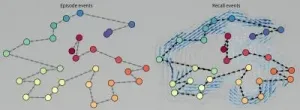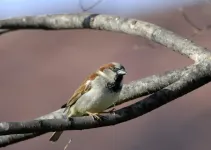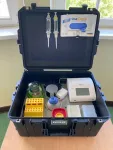(Press-News.org) Your brain is constantly evaluating which aspects of your experiences to either remember for later, ignore, or forget. Dartmouth researchers have developed a new approach for studying these aspects of memory, by creating a computer program that turns sequences of events from a video into unique geometric shapes. These shapes can then be compared to the shapes of how people recounted the events. The study provides new insight into how experiences are committed to memory and recounted to others. The results are published in Nature Human Behavior and were based on how people remembered the experience of watching an episode of Sherlock, a BBC television show.
"When we represent experiences and memories as shapes, we can use the tools provided by the field of geometry to explore how we remember our experiences, and to test theories of how we think, learn, remember, and communicate," explained senior author Jeremy R. Manning, an assistant professor of psychological and brain sciences, and director of the Contextual Dynamics Lab at Dartmouth. "When you experience something, its shape is like a fingerprint that reflects its unique meaning, and how you remember or conceptualize that experience can be turned into another shape. We can think of our memories like distorted versions of our original experiences. Through our research, we wanted to find out when and where those distortions happen (i.e. what do people get right and what do people get wrong), and examine how accurate our memories of experiences are," he added.
The Dartmouth research team examined a public dataset containing brain recordings from 17 people who had watched the Sherlock episode and then described what had happened in their own words. The dataset also contained detailed scene-by-scene annotations of the episode. The team ran those annotations through their computer program to identify 32 unique topics or themes that were present in each moment of the episode. Through computer modeling, the researchers then created a "topic model" of the episode, which was comprised of 32 dimensions to reflect each thematic topic. Different moments of the episode that reflected similar themes were assigned to nearby locations in the 32-dimensional space. When these results are visualized in 2D, a connect-the-dots-like representation of successive events emerges. The shape of that representation reflects how the thematic content of the episode changes over time, and how different moments are related. The researchers used an analogous process to obtain the shapes of how each of the 17 participants recounted the events of the episode.
When the geometric shapes representing the Sherlock episode were compared to the shapes representing a participant's recounting of it, the researchers were able to identify which aspects of the episode people tended to remember accurately, forget or distort. The coarse spatial structure of the episode's shape reflects the major plot points and acts like a building's scaffolding. The shape of every participant's recounting reproduced this coarse-scale scaffolding, indicating that every participant accurately remembered the major plot points. The episode's shape also comprises finer-scale structure, analogous to architectural embellishments and decorations, that reflected specific low-level conceptual details. Some participants accurately recounted many of those low-level details, whereas others recounted only the high-level plot points.
"One of our most intriguing findings was that, as people were watching the episode, we could use their brain activity patterns to predict the distorted shapes that their memories would take on when they recounted it later," explained Manning. "This suggests that some of the details about our ongoing experiences get distorted in our brains from the moment they are stored as new memories. Even when two people experience the same physical event, their subjective experiences of that event start to diverge from the moment their brains start to make sense of what happened and distill that event into memories."
The research team plans to apply their approach to other domains, including in health and education, as their methods of modeling the shapes of memories could be used to provide a more nuanced way of assessing if a patient will understand or remember what their doctor is telling them, or whether a student understands specific concepts in a course lecture.
INFORMATION:
Manning is available for comment at: jeremy.r.manning@dartmouth.edu. Andrew C. Heusser, a former postdoctoral researcher in the Contextual Dynamics Lab, who is now working for Akili Interactive and Paxton C. Fitzpatrick '19, lab manager and research assistant in the Contextual Dynamics Lab at Dartmouth, served as co-first authors of the study.
Considered the most lethal form of DNA damage, double-strand breaks must be repaired to prevent cell death. In developing therapies for hard-to-treat breast and ovarian cancers in patients with BRCA gene mutations, scientists aim to identify ways to keep cancer cells from using DNA break repair pathways. New findings demonstrate a previously-unknown capability for polymerase theta (pol theta) - a key enzyme in this repair function - that shows promise as a new avenue for treatment development.
The study results are published in Molecular Cell.
Researchers at the University of Vermont (UVM), The University of Texas MD Anderson ...
CORVALLIS, Ore. - A survey of more than 18,000 land parcels spanning 2 million square miles across 63 countries shows that a "protected area" designation reduces the rate of deforestation but does not prevent it.
Published today in Nature Ecology and Evolution, the findings are important because most terrestrial species live in forests and because the study suggests that just 6.5% of the Earth's woodlands are truly protected, well below the 2020 target of 17% set by the United Nations' Convention on Biological Diversity.
The findings are also timely given President Biden's recent executive order on climate change, which calls for protecting 30% of the United States' ...
Observations of lithium and potassium around white dwarf stars point to remains of rocky planet crusts
Analysis by astronomers led by University of Warwick shows chemical composition of crusts is very similar to Earth's continental crust
The outer layers of the white dwarfs contain up to 300,000 gigatonnes of rocky debris, which includes up to 60 gigatonnes of lithium and 3,000 gigatonnes of potassium
These white dwarfs are among the oldest stars in our galaxy, and could host one of the oldest planetary systems discovered so far
Remnants of planets with Earth-like crusts have been discovered in the atmospheres of four nearby white dwarf stars by University of Warwick astronomers, offering a glimpse of the planets that may have once orbited ...
BOSTON -- Sleep and health are inextricably connected. New research from investigators at Brigham and Women's Hospital explores the connection between sleep disturbances and deficiencies among older adults and risk of dementia and death, finding that risk of dementia was double among participants who reported getting less than five hours of sleep compared to those who reported 7-8 hours of sleep per night. The team also found associations between sleep disturbance and sleep deficiency with overall risk of death. Results are published in Aging.
"Our findings illuminate a connection between sleep deficiency and risk of dementia and confirm the importance of efforts to help older individuals obtain ...
Combination of pine scent and ozone as super source of particulate emissions from coniferous forests
Scientists have managed to figure out why conifer forests produce so many fine particles into the atmosphere. Aerosol particles are particularly abundant when ?-pinene, the molecule responsible for the characteristic pattern of pine trees reacts with atmospheric ozone.
Atmospheric aerosol particles affect the Earth's climate by forming clouds, but at the same time they also pollute the air, thereby increasing mortality.
Aerosol particles in the atmosphere have their origins in many sources. The significant amount of aerosol particles in the atmosphere is caused ...
Multiple sclerosis (MS) is the most common neurological disease in young adults, affecting more than 2 million individuals worldwide, with about 1500 cases in Estonia. About 20% of MS patients experience optic neuritis (ON) as the presenting symptom, but not all ON patients develop MS.
The TalTech gene technology research unit, in collaboration with the laboratory of Protobios OÜ and medical researchers of the University of Helsinki, published their findings in the prestigious journal of EBioMedicine entitled "Identification of two highly antigenic epitope markers predicting multiple sclerosis in optic neuritis patients". The lead author Helle Sadam and co-authors Mariliis Jaago and Annika ...
Ithaca, NY--The European House Sparrow has a story to tell about survival in the modern world. In parts of its native range in Europe, House Sparrow numbers are down by nearly 60%. Their fate in the U.S. and Canada is less well known. A new study by Cornell Lab of Ornithology scientists aims to clarify the status of this non-native species, using 21 years of citizen science data from the Cornell Lab's Project FeederWatch. The results are published in the Wilson Journal of Ornithology.
"We wanted to find out where and how much House Sparrows might be declining here," explains lead author Liam Berigan, who did this work while at the Cornell Lab and who is now a Ph.D. student at the University of Maine. "We also explored whether the declines would match up with an increase in hawk ...
The CIPD is today launching a new research report, co-authored by the University of Bath's Dr Luke Fletcher, to highlight how LGBT+ workers tend to have a more negative experience of work.
'Inclusion at work: Perspectives on LGBT+ working lives' draws on data from the CIPD's UK Working Lives Survey and a separate survey of trans workers to explore their perspectives on working life, hence the intentional use of LGB+ rather than LGBT, in the research findings:
Over 40% of LGB+ workers experienced a conflict at work over a twelve-month period, compared with 29% of heterosexual workers. Conflicts typically involve being undermined/ humiliated or discriminatory behaviour aimed at a protected characteristic.
More than half (55%) of trans workers surveyed said they had experienced conflict ...
A commercially available genomic test may help oncologists better determine which patients with recurrent prostate cancer may benefit from hormone therapy, according to new research from the Johns Hopkins Kimmel Cancer Center and 15 other medical centers.
Researchers studied prostate cancer samples from 352 participants in the NRG/RTOG 9601 clinical trial, which compared radiation therapy alone with radiation therapy combined with hormone therapy. The investigators found that the Decipher test, which measures the activity of 22 genes among seven known cancer pathways, independently estimated the participants' risk of metastasis, death from prostate cancer and overall ...
The PCR test is the most accurate tool to identify SARS-CoV-2. However, valid results are often available only after days. Moreover, the laboratory must be well equipped, have trained personnel and sufficient financial resources. All of this is usually a problem in Africa. A portable suitcase could help. In cooperation with several African universities, scientists at Leipzig University have found that this mini-laboratory provides test results that are almost as good as a PCR test - and almost in real time. The researchers have now published their findings in the journal "Analytical Chemistry".
The compact case could provide rapid coronavirus test results in regions of ...





